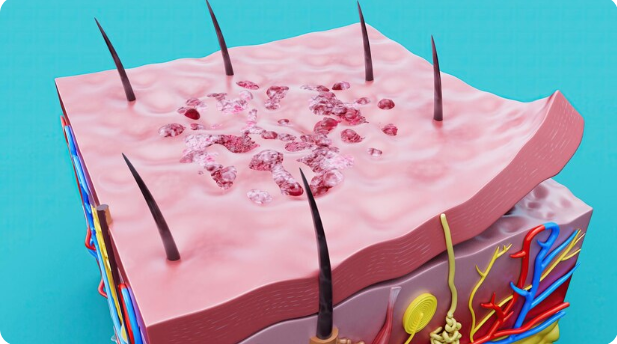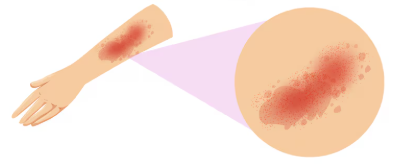 Nickel Allergy Symptoms Often Show Up as Dermatitis
Nickel Allergy Symptoms Often Show Up as Dermatitis
Nickel allergy often shows up as dermatitis (inflammation of the skin)—a pretty common skin reaction that flares up when you’re in contact with things containing nickel. It’s like when your skin gets all red and itchy after wearing certain jewellery.
This happens because your immune system treats nickel like a harmful invader and kicks into defence mode. It’s the body’s way of saying, “Hey! I don’t like this!”
This immune response is triggered by the release of chemicals in the skin cells where the nickel landed. But what’s really going on underneath the surface?
Nickel Allergy Immune Response: What Happens Beneath the Skin
When nickel first touches your skin, it slips through the outer layer and binds to proteins, forming tiny complexes. Your immune system picks up on this—specifically, special skin cells called Langerhans cells, which carry the nickel complex to your lymph nodes. There, your T-cells get “sensitized,” meaning they now see nickel as an intruder. No rash appears at this point—but your immune system remembers.
The next time you’re exposed? That’s when things heat up. Those memory T-cells recognize the nickel and spring into action. But this doesn’t happen instantly—it’s a delayed reaction, often taking up to 72 hours to show up. Once activated, T-cells release cytokines, chemical messengers that call in reinforcements and trigger inflammation. That’s what causes the itchy, red, sometimes blistery patches we call nickel dermatitis.
Imagine this on a microscopic level: tiny immune soldiers rushing to defend your body. Fascinating—but incredibly annoying for anyone living with nickel allergy.
Visible Nickel Allergy Symptoms on the Skin
When nickel touches the skin, it starts to break through the outer layers—think of these layers as brick walls protecting your insides. Nickel acts like a wrecking ball, creating microscopic cracks. The result? Dermatitis. Your skin might swell, itch, and turn red, almost like a rogue sunburn.
How severe your reaction gets usually depends on how much nickel and how long your skin was in contact with it. A quick brush might just give you a light itch. But wearing a metal watch or belt buckle all day? That can trigger a full-blown reaction.
Common Nickel Allergy Triggers in Everyday Life
Understanding how all this works means you can start recognizing and avoiding sneaky sources of nickel. Items like jewellery, buttons, keys, coins, and even phone cases can be culprits. Opting for nickel-free alternatives or coating metal surfaces with clear nail polish can really help.
 Managing Acute Reactions to Nickel Exposure
Managing Acute Reactions to Nickel Exposure
Sometimes the reaction is sharp and immediate. Picture sudden swelling, relentless itching, and that angry red rash from brushing up against something metal—like glasses, earrings, or your favourite pair of jeans with a metal button. Your immune system goes into overdrive, fast.
Beneath the surface, things are heating up. Blood vessels widen, causing redness. Skin barriers break down, letting irritants in and locking moisture out—leaving your skin dry and flaky.
Treatment and Prevention: What You Can Do About It
Managing these reactions starts with smart prevention—and quick action when flare-ups happen. Having antihistamines on hand can help calm things down. In more severe cases, topical corticosteroids may be recommended to reduce inflammation and ease discomfort.
Being nickel-smart can save you a lot of frustration. Look for product labels that say “nickel-free,” choose hypoallergenic earrings, and keep barrier creams around if you can’t avoid metal contact.
Final Thoughts: Staying Ahead of Nickel Allergy Flare-Ups
Dealing with nickel allergy means more than just reacting—it’s about staying one step ahead. By understanding how your immune system responds and knowing where nickel hides, you can dodge those flare-ups and give your skin the peace it deserves. Choosing wisely isn’t just smart—it’s empowering.

Really helpful post. Thank you for breaking it down so clearly! I’ve always known some jewellery made my skin itchy, but I never quite understood what was going on beneath the surface. The explanation about the immune response and delayed reaction was eye-opening.
I also didn’t realise how many everyday items could trigger it, especially coins and phone cases! Definitely going to be more mindful about that.
Quick question: Does repeated exposure to nickel make future reactions worse, or does the sensitivity level usually stay the same over time?
Hi Sharon,
Great question.
Repeated exposure to nickel items that initially caused reactions tends to worsen as it puts your immune system into constant fight mode.
Your system then becomes overly sensitive to any trace of amounts of nickel..
Depending on what you’re in contact with has a lot to do with the extent of the reaction.
Hope this helps you.
This was a really eye-opening read! I had no idea that nickel allergy works through a delayed, T-cell mediated response—basically Type IV hypersensitivity—where nickel ions bind to skin proteins, create the hapten-carrier complex, and trigger a reactive T-cell response. The fact that your immune system has to be sensitized first and then reacts 12–72 hours later with itching, redness, and possibly blisters really put things in perspective. And learning that some people even develop systemic reactions when ingesting nickel was new to me! Do you have any suggestions for nickel-free alternatives or practical strategies for avoiding contact in everyday life? Thanks for sharing these insights!
Hi Bob,
Thanks for taking the time. There are alternative options available such as titanium, nickel free stainless steel alloys and ceramics to name a few. Manufactures are making an effort to inform consumers that options are available. Some people being hyper sensitive can experience negative responses to nickel in as little as a few hours after contact. Are you also impacted by products containing nickel?